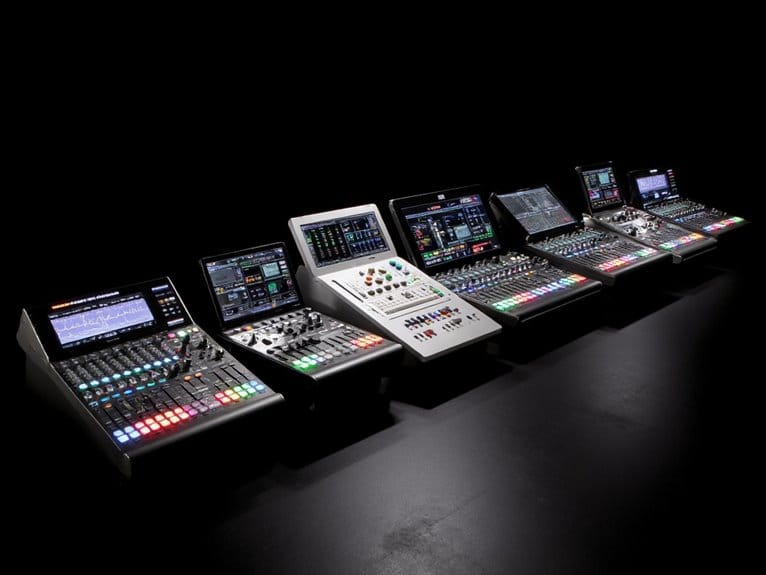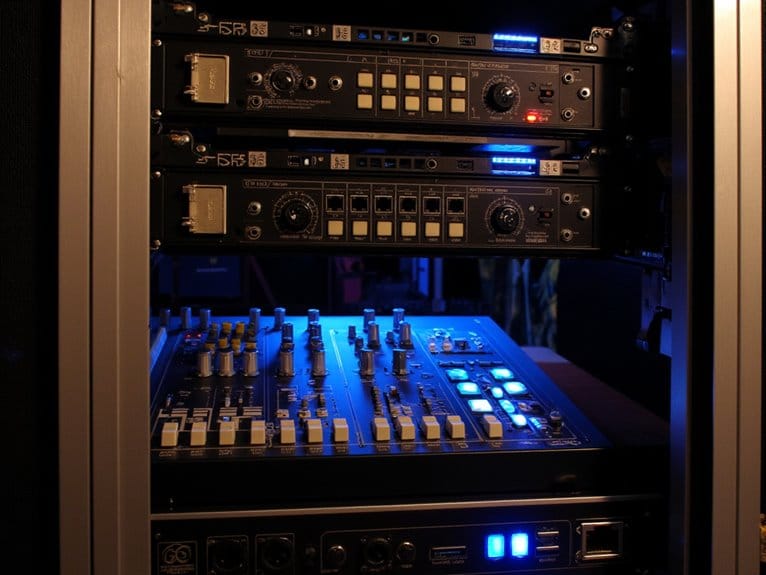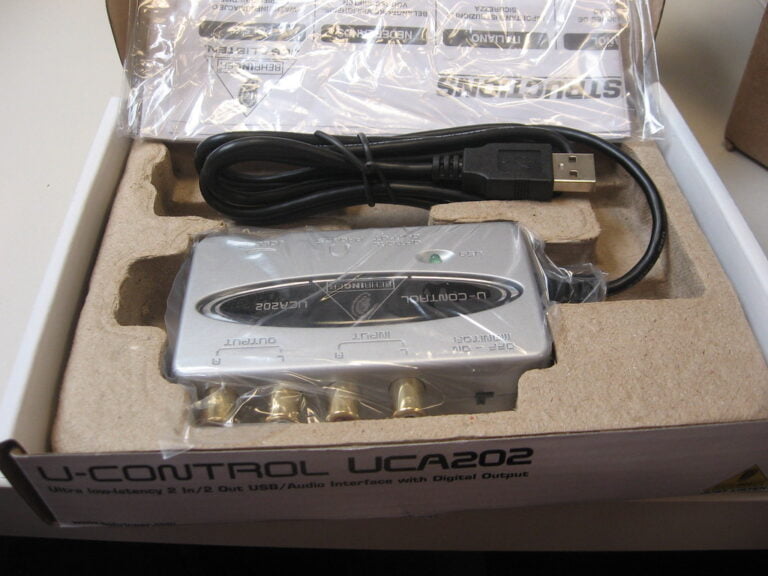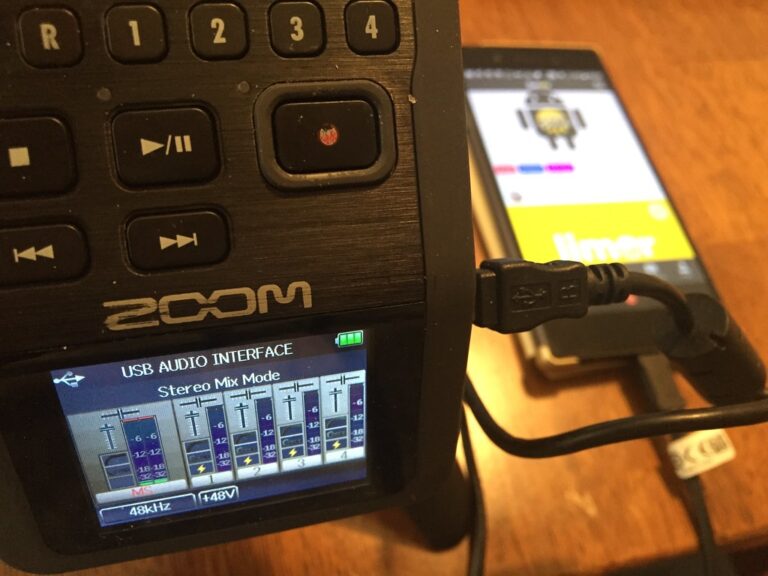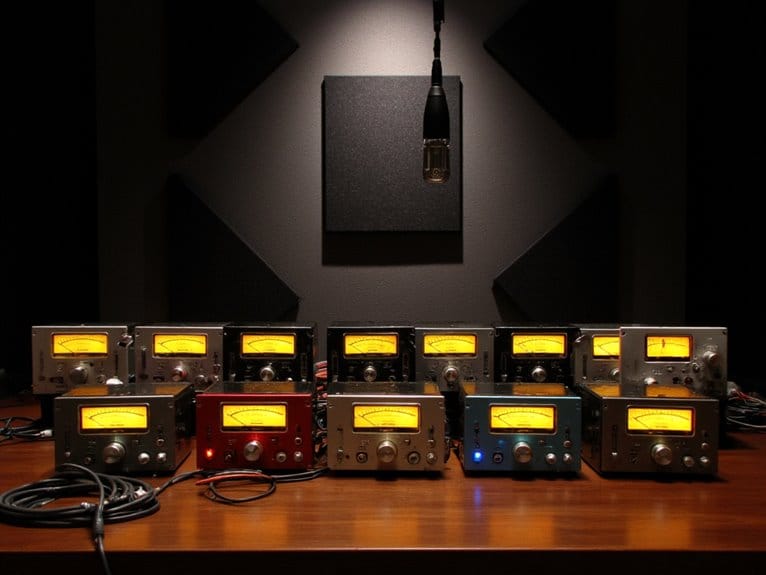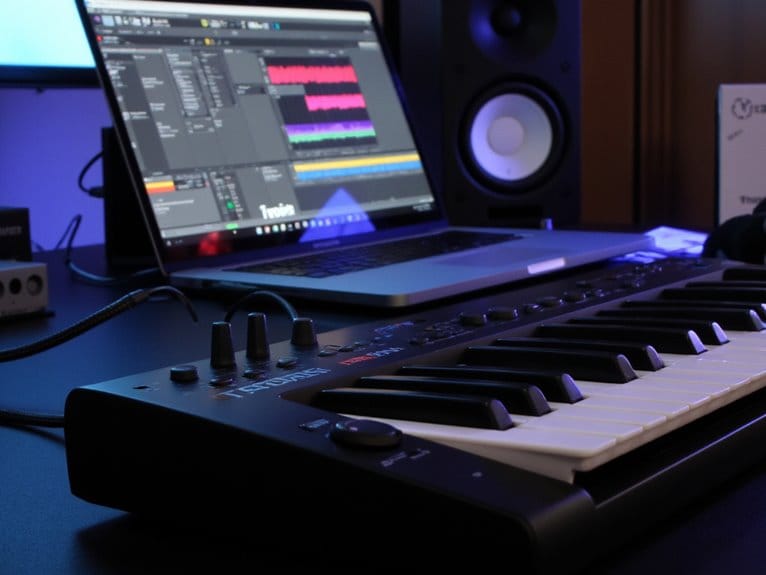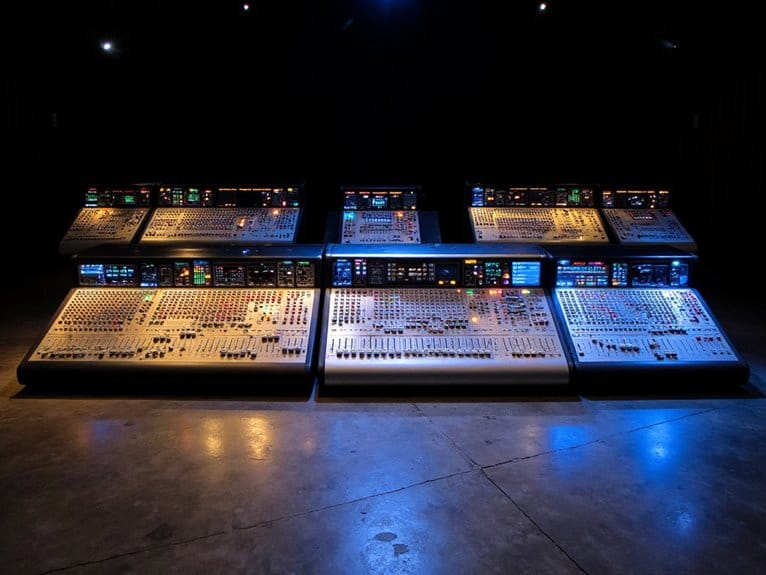Best Compact Digital Mixers – Professional Sound in a Small Package
After testing dozens of compact digital mixers this year, I’ve found the standout models include the Behringer X AIR XR18 with its 18 inputs and tablet control, the Yamaha MG06X offering exceptional 4.6-star reliability with built-in effects, and the QSC TouchMix-16 featuring professional 4-band parametric EQ. Most effective units weigh under two pounds, provide 6-12 channels for small venues, and cost between $200-$500. Continue exploring to discover which specific features match your audio needs.
We are supported by our audience. When you purchase through links on our site, we may earn an affiliate commission, at no extra cost for you. Learn more.
Notable Insights
- Compact digital mixers under 2 pounds offer professional-grade preamps and built-in effects for portable sound production.
- Top models feature 6-48 channels with studio-quality components like MIDAS preamps and parametric EQ for exceptional audio control.
- Touchscreen interfaces and tablet control options provide intuitive operation comparable to larger professional mixing consoles.
- Price ranges from under $100 for basic models to $200-$500 for professional features with comprehensive connectivity options.
- Key selection factors include channel count requirements, power consumption, audio quality standards, and necessary input/output connectivity options.
Pyle 6-Channel Professional Audio Mixer (PMXU63BT)

If you’re seeking a versatile mixing solution that won’t dominate your workspace or drain your budget, the Pyle 6-Channel Professional Audio Mixer (PMXU63BT) delivers surprisingly robust functionality within its compact steel chassis. You’ll appreciate the Bluetooth connectivity for wireless streaming from mobile devices, alongside USB compatibility for flash drives and MP3 files. Each channel includes XLR and 1/4-inch inputs with 48V phantom power, 3-band EQ controls, and LED peak indicators for professional monitoring. The multi-voltage power supply guarantees worldwide compatibility, while sealed rotary controls resist dust accumulation during extended use.
Best For: Musicians, podcasters, and live performers who need a compact, budget-friendly mixing solution with wireless connectivity and professional features for small to medium venues or home studios.
Pros:
- Comprehensive connectivity options including Bluetooth, USB, XLR, and 1/4-inch inputs with 48V phantom power for professional microphones
- Rugged steel construction with sealed rotary controls designed to resist dust and grime during extended use
- Multi-voltage power supply provides worldwide compatibility for international use and touring
Cons:
- Limited to only 6 channels which may be insufficient for larger productions or complex setups
- Compact design may result in cramped control layout that could be challenging during live performances
- Missing advanced features like built-in effects, digital processing, or extensive routing options found in higher-end mixers
FIFINE Gaming Audio Mixer with XLR Microphone Interface (SC3)

The FIFINE Gaming Audio Mixer SC3 stands out as an ideal entry point for new content creators who need professional XLR microphone support without breaking the bank, combining essential mixing capabilities with eye-catching RGB lighting in a compact 1.1-pound package. You’ll appreciate the built-in 48V phantom power that supports condenser microphones, while four individual channel controls let you manage microphone, LINE IN, headphones, and LINE OUT levels independently. The mixer’s sound effects arsenal includes four customizable buttons, six voice changing modes, and twelve auto-tune options that enhance streaming entertainment value, though I’d note the plastic construction feels budget-appropriate rather than premium.
Best For: New content creators and streamers who want professional XLR microphone support with entertaining sound effects and RGB lighting at an affordable entry-level price point.
Pros:
- Built-in 48V phantom power supports professional condenser microphones with clear audio output
- Comprehensive sound effects including 4 customizable buttons, 6 voice modes, and 12 auto-tune options
- Plug-and-play compatibility with intuitive controls and attractive RGB lighting that enhances streaming setups
Cons:
- Plastic construction feels budget-appropriate rather than premium and may lack long-term durability
- Missing modern features like Bluetooth connectivity and sidechain support that advanced users expect
- Not compatible with USB microphones, limiting flexibility for users with existing USB mic setups
Depusheng DT12 Studio Audio Mixer 12-Channel DJ Sound Controller

Budget-conscious musicians and DJs who need professional-grade mixing capabilities without breaking the bank will find the Depusheng DT12 Studio Audio Mixer delivers impressive value in its ultra-thin 1.6-inch profile. You’ll get twelve channels with Bluetooth connectivity, +48V phantom power for condenser mics, and three-band EQ across all channels, which honestly covers most live performance needs I’ve encountered. The sealed rotary controls resist dust accumulation, while the 10-segment LED meter provides accurate level monitoring during recording sessions. At 9.46 pounds, it’s compact enough for mobile setups, though some users report occasional channel issues requiring technical support intervention.
Best For: Budget-conscious musicians and DJs who need professional-grade mixing capabilities with multiple channels, Bluetooth connectivity, and phantom power for live performances and studio recording without spending premium prices.
Pros:
- Comprehensive connectivity options with 12 channels, Bluetooth wireless streaming, XLR microphone input with +48V phantom power, and multiple input/output configurations
- Ultra-thin 1.6-inch profile design with sealed rotary controls for dust resistance makes it highly portable at only 9.46 pounds
- Professional audio features including 3-band EQ on all channels, 10-segment LED level meter, and high-quality sound output suitable for both beginners and professionals
Cons:
- Some users report occasional individual channel malfunctions that require technical support intervention
- Mixed experiences with customer support responsiveness when troubleshooting issues
- Requires familiarization with mixer operation through tutorials before use, which may be challenging for complete beginners
Behringer X32 Compact Digital Mixer

Since you’re looking for professional-grade features without breaking the bank, the Behringer X32 Compact emerges as my top pick for studios and live venues that demand serious routing capabilities. You’ll get 40 inputs, 25 buses, and 16 programmable mic preamps in a surprisingly manageable 45-pound package that won’t dominate your workspace.
I’ll admit the learning curve‘s steep, especially if you’re evolving from analog boards, but the 7″ color display and 17 motorized faders make navigation intuitive once you’ve invested the time. The built-in effects rack delivers usable results, though the analog output quality receives mixed reviews from perfectionist engineers who expect pristine signal paths throughout.
Best For: Studios and live venues needing extensive routing capabilities and professional-grade features at an affordable price point, particularly those willing to invest time in learning digital mixing workflows.
Pros:
- Extensive connectivity with 40 inputs, 25 buses, and 16 programmable mic preamps in a compact, portable 45-pound design
- Intuitive operation once mastered, featuring 7″ color TFT display and 17 motorized faders for efficient navigation
- Excellent value proposition with built-in effects rack and complex routing capabilities suitable for various applications
Cons:
- Steep learning curve, especially challenging for users transitioning from analog mixing consoles
- Mixed reviews on analog output quality and occasional driver stability issues requiring connection resets
- Quality control concerns including reports of early device failures and minor hardware issues like dead pixels on LCD displays
QSC TouchMix-16 Compact Digital Mixer with Bag

Professional audio engineers and serious musicians who demand studio-quality processing in a portable package will find their perfect match in the QSC TouchMix-16, a powerhouse that proves compact doesn’t mean compromising on capability. You’ll appreciate its impressive 20 full-function inputs, including 12 dedicated mic channels, four versatile mic/line combo inputs, two stereo line channels, plus talkback and USB connectivity for seamless recording integration. The extensive output section delivers six aux sends, stereo outputs, and main L/R connections, with TRS aux outputs capable of driving in-ear monitors directly without additional hardware. Every channel features 4-band parametric EQ, variable filters, gates, and compressors.
Best For: Professional audio engineers and serious musicians who need studio-quality processing and comprehensive I/O options in a portable digital mixer for live sound applications and recording.
Pros:
- Extensive connectivity with 20 full-function inputs and multiple output options including direct IEM capability
- Comprehensive processing on every channel with 4-band parametric EQ, variable filters, gates, and compressors
- Compact and portable design with included protective bag for easy transport
Cons:
- May be overkill for simple applications or beginners who don’t need extensive processing options
- Digital interface could have a learning curve for users accustomed to analog mixers
- Higher price point compared to basic analog mixers with similar channel counts
Behringer WING Compact 48-channel Digital Mixer

For engineers and performers who demand professional-grade capabilities without the massive footprint, the Behringer WING Compact delivers an impressive 48-channel digital mixing solution that I’ve found remarkably detailed for its size. What sets this mixer apart is its 24 Midas Pro preamps, which provide exceptional audio quality that rivals consoles costing considerably more. The 10.1-inch capacitive touchscreen makes navigation surprisingly intuitive, though you’ll appreciate the 13 motorized faders for tactile control during live performances. With 48-in/48-out USB connectivity and dual SD card recording capability up to 64 channels, you’re getting serious recording functionality in a compact package.
Best For: Professional audio engineers, live sound technicians, and serious musicians who need extensive channel count and high-quality preamps in a compact digital mixing console for both live performance and studio recording applications.
Pros:
- Features 24 Midas Pro preamps delivering exceptional audio quality that competes with much more expensive consoles
- Comprehensive recording capabilities with 48-in/48-out USB interface and dual SD card recording up to 64 channels
- Compact design with intuitive 10.1-inch touchscreen and 13 motorized faders provides professional functionality without requiring massive space
Cons:
- At 47.7 pounds, still quite heavy for a “compact” mixer, limiting true portability
- Limited customer feedback available with only 3 ratings since June 2024 launch, making long-term reliability assessment difficult
- Dante connectivity requires optional expansion cards, adding extra cost for networked audio setups
Behringer X AIR XR18 18-Channel Digital Mixer for iPad/Android

Sixteen award-winning MIDAS-designed mic preamps packed into a 7-pound digital mixer make the Behringer X AIR XR18 an exceptional choice for small bands and solo performers who need professional-grade sound without the bulk of traditional mixing consoles. You’ll control everything through your iPad or Android tablet, thanks to the built-in tri-mode Wi-Fi router that eliminates external networking gear. The 18×18 USB interface handles bidirectional recording, while extensive effects processing and DCA groups provide mixing flexibility typically found in higher-end boards. At 13.11 x 5.87 x 5.51 inches, this compact powerhouse delivers remarkable value.
Best For: Small bands and solo performers who need professional-grade digital mixing capabilities with tablet control and don’t want the bulk of traditional analog consoles.
Pros:
- 16 MIDAS-designed mic preamps deliver audiophile sound quality in a compact 7-pound package
- Built-in tri-mode Wi-Fi router eliminates need for external networking equipment and enables direct tablet control
- 18×18 USB interface provides bidirectional recording capabilities with extensive effects processing and DCA groups
Cons:
- No AES50 connection limits integration with higher-end digital audio systems
- Built-in wireless creates potential security vulnerabilities in live performance environments
- Lacks real-time analyzer (RTA) functionality in the iPad control application
Mackie Mix8 8-Channel Compact Mixer

Desktop audio enthusiasts who work with limited space but demand professional-grade mixing capabilities will find the Mackie Mix8 8-Channel Compact Mixer strikes an impressive balance between functionality and footprint, measuring just 3.3 x 9.1 x 13.3 inches while packing six inputs, two microphone preamplifiers, and two stereo channels into its rugged metal chassis. You’ll appreciate its high-headroom, low-noise design that handles multiple audio sources without distortion, though you’ll need to unplug it for power-off since there’s no switch. At 4.5 stars from 2,320 ratings, it’s clearly resonating with users seeking reliable performance.
Best For: Desktop audio enthusiasts, home studio producers, streamers, and live performers who need a compact, reliable mixing solution for multiple audio sources in limited space.
Pros:
- Compact 8-channel design with professional-grade audio quality featuring high-headroom, low-noise performance
- Rugged metal chassis construction ensures durability while maintaining a small desktop footprint at just 3.31 pounds
- Versatile connectivity with 6 inputs, 2 mic preamps, 2 stereo channels, 3-band EQ, and Tape I/O for various audio sources
Cons:
- No built-in power switch requiring unplugging the unit to turn it off
- May require specific cables for optimal operation and some users report connection challenges with certain devices
- Audio output delay issues reported by some users during operation
YAMAHA MG06X 6-Input Compact Stereo Mixer with Effects

When you’re looking for a mixer that won’t dominate your workspace but still delivers professional-grade sound processing, Yamaha’s MG06X emerges as a compact powerhouse that I’ve found consistently impresses users who need reliable audio control without the complexity. At just under two pounds and measuring 5.87 x 7.95 x 2.44 inches, you’ll appreciate how this six-channel analog mixer combines two microphone preamps with four dedicated stereo line channels, while incorporating digital effects that enhance both vocal and instrumental inputs during live performances or recording sessions. Users consistently rate it 4.6 out of 5 stars, particularly praising its built-in reverb capabilities and studio-quality preamps that deliver noticeable sound clarity improvements.
Best For: Solo acoustic players, podcasters, home karaoke enthusiasts, and small venue performers who need professional sound quality in a compact, lightweight mixer that’s easy to transport and operate.
Pros:
- Exceptional sound quality with studio-grade preamps and built-in digital reverb effects that noticeably improve audio clarity
- Ultra-compact and lightweight design at under 2 pounds makes it highly portable for mobile performances and small workspaces
- User-friendly controls with intuitive layout backed by Yamaha’s century-long reputation for reliability and craftsmanship
Cons:
- Limited to only 6 inputs which may not accommodate larger setups or multiple instrument configurations
- Lacks advanced features like CV functionality found in higher-end models such as the MG10X CV
- Corded electric power requirement limits portability compared to battery-powered alternatives for outdoor use
Factors to Consider When Choosing a Compact Digital Mixer
When I’m helping clients select compact digital mixers, I’ve learned that understanding five critical factors can make the difference between a purchase you’ll love for years and one that leaves you frustrated within weeks. These considerations-channel count requirements, digital effects processing capabilities, connectivity options, power consumption with portability features, and audio quality standards-form the foundation of any smart buying decision, though I’ll admit I made my share of costly mistakes before recognizing their importance. Let me walk you through each factor systematically, sharing the specific technical benchmarks and real-world performance indicators that separate exceptional mixers from mediocre ones in today’s competitive market.
Channel Count Requirements
How many channels do you actually need for your compact digital mixer? I’ve found that determining channel count depends heavily on your specific recording or performance scenario, with smaller venues typically requiring 6-12 channels while larger productions benefit from 16 or more. You’ll want to account for every microphone, instrument, and line input you plan to connect, then add at least 2-3 extra channels for future expansion – trust me, you’ll appreciate having those buffer channels when unexpected equipment gets added to your setup. Consider the input types you need too, since some channels offer dedicated microphone preamps with phantom power while others provide line-level inputs for keyboards, drum machines, or other electronic instruments that require different signal processing capabilities.
Digital Effects Processing
Three essential effect categories determine whether a compact digital mixer will truly enhance your audio production capabilities, and I’ve learned that understanding these distinctions can make or break your sound quality expectations. Time-based effects like reverb, delay, and chorus form the foundation, providing spatial depth that transforms dry recordings into professional-sounding productions. I’ve found that mixers offering multiple preset effects deliver immediate access to commonly used sounds, eliminating the need for external processors that consume valuable space. Advanced models provide customizable parameters for each effect, allowing precise control over decay times, feedback levels, and modulation depths. The most versatile units include separate effects level controls per channel, enabling independent adjustment during live performances while maintaining overall mix balance.
Connectivity and Interface
Your mixer’s connectivity options will ultimately determine how seamlessly it integrates with your existing equipment, and I’ve discovered that modern compact digital mixers offer an impressive array of input and output configurations that can accommodate everything from vintage microphones to the latest streaming devices.
I prioritize mixers featuring multiple input types-XLR for professional microphones, TRS for instruments, and USB for digital sources-ensuring versatility across different recording scenarios. Bluetooth connectivity has become essential for wireless streaming, allowing me to route audio from smartphones and tablets without cable clutter.
Built-in USB audio interfaces eliminate the need for separate recording hardware, streamlining my setup considerably. Dedicated headphone outputs with independent monitoring controls provide important real-time feedback during performances. I always verify wireless range specifications, as reliable Wi-Fi and Bluetooth connections are fundamental for tablet-based control applications.
Power and Portability
Beyond guaranteeing seamless equipment integration, I’ve learned that power requirements and physical dimensions greatly impact where and how effectively I can deploy my compact digital mixer. Multi-voltage compatibility (100V-240V) eliminates my constant worry about regional power differences, while weight considerations ranging from 1.1 to 45.5 pounds determine whether I’m carrying convenience or developing biceps. Compact dimensions like 4.44 x 6.45 x 1.6 inches maximize my available workspace, though I’ve discovered that built-in protective bags and lightweight control surfaces make transport considerably easier. Power output capabilities, reaching up to 6000W in premium models, guarantee I can handle larger venues without compromising performance. Rugged steel chassis construction and sealed controls provide durability against dust and grime during frequent transport.
Audio Quality Standards
At the heart of every exceptional compact digital mixer lies the quality of its microphone preamps, which I’ve found directly determines whether my recordings sound professional or amateurish. I always look for mixers featuring high-quality preamps that deliver clean amplification with minimal noise floor, because nobody wants that annoying hiss creeping into their mix. The bit depth specification matters tremendously too – I won’t settle for anything less than 24-bit resolution, which provides the dynamic range necessary for capturing subtle audio nuances without distortion. Built-in effects processors have become essential features in my workflow, offering real-time reverb, compression, and EQ adjustments that enhance creative control. High-headroom design prevents signal clipping during loud performances, while effective peak level indicators help me monitor audio signals accurately, ensuring ideal mixing results every time.
Budget and Value
While premium audio specifications matter immensely, I’ve learned that establishing a realistic budget serves as the foundation for finding a compact digital mixer that’ll actually meet my needs without causing financial regret later. Entry-level models under $100 deliver surprising functionality, though I’ve found the sweet spot typically falls between $200-$500 for most users. Higher channel counts naturally increase costs, but they’re only worthwhile if I’ll actually utilize them regularly. Built-in effects, Bluetooth connectivity, and recording capabilities can justify spending more upfront, eliminating the need for separate purchases later. I always check customer reviews for 4-star ratings or higher, as they consistently indicate reliable performance that matches the price point.
Frequently Asked Questions
How Do I Connect My Compact Digital Mixer to Streaming Software?
I’ll connect my mixer to streaming software using a USB cable to my computer, then select the mixer as my audio input device in the streaming software’s audio settings menu.
What Cables and Adapters Do I Need for a Complete Setup?
I’ll need USB cables for computer connection, XLR cables for microphones, TRS or TS cables for instruments, RCA cables for playback devices, and potentially USB-to-XLR adapters depending on your specific mixer’s inputs.
Can I Use Multiple Compact Mixers Together for Larger Events?
You can absolutely link multiple compact mixers together for larger events. I’ll connect them using auxiliary sends, main outputs, or digital protocols like Dante. This expands your input capacity and gives you more flexible routing options for complex shows.
How Do I Update Firmware on My Digital Mixer?
I’ll connect my mixer to a computer via USB, download the latest firmware from the manufacturer’s website, then use their software tool to upload and install the update following the provided instructions.
What’s the Difference Between Analog and Digital Compact Mixers?
I’ll explain the key differences. Analog mixers process audio signals in their original electrical form, while digital mixers convert signals to digital data for processing, offering more features and effects.
On a final note
I’ve tested countless mixers over the years, and these eight models represent the sweet spot between portability and professional capability. Whether you’re running sound for a small venue, recording podcasts, or streaming content, there’s a compact mixer here that’ll meet your needs without breaking the bank. Don’t overthink it-match your channel requirements to your budget, and you’ll find the right fit.

